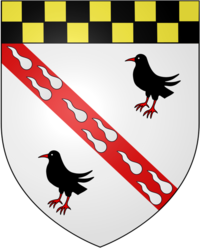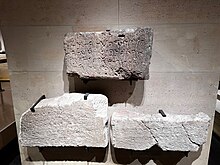Portal:Biography
A biography, or simply bio, is a detailed description of a person's life. It involves more than just basic facts like education, work, relationships, and death; it portrays a person's experience of these life events. Unlike a profile or curriculum vitae (résumé), a biography presents a subject's life story, highlighting various aspects of their life, including intimate details of experience, and may include an analysis of the subject's personality. (Full article...)
Featured biographies

Gabriel Pleydell (fl. 1519 – c.1591) of Midg Hall in the parish of Lydiard St John (later Lydiard Tregoze) in Wiltshire, was an English landowner and politician who served as Member of Parliament for the Wootton Bassett and Marlborough constituencies in the Parliament of England. Pleydell was born before 1519 into a large, affluent family. He entered politics in March 1553 as a member for Wootton Bassett, close to his family estate at Midgehall in Wiltshire. Pleydell's election to the Marlborough constituency two years later may have been made possible by his father's influential connections. He returned to the Wootton Bassett seat at the request of Sir John Thynne in 1563; he had supported Thynne in a dispute over the Knighthood of the Shire in 1559.
Pleydell's political and personal life is marked by legal controversy. Almost always a defendant in court, known allegations include the forced expulsion of residents from a country manor, forcible entry into and seizure of goods from a private property, unlawfully protecting convicts from justice, forging documents for his own benefit, and illegal hunting. He was alleged to be one of the ringleaders of a plot to exile Queen Mary of England, and is perhaps best known for his contentious claim of parliamentary privilege after he was found guilty of this offence in 1555, an action which caused serious disagreement between the House of Commons and the House of Lords. Legal accusations for most of his political career and imprisonment in Fleet Prison and the Tower of London helped "confirm for Gabriel Pleydell a niche in parliamentary history", according to a modern historian. He died between 19 December 1590 and 3 February 1591. (Full article...)
Olivia Shakespear (née Tucker; 17 March 1863 – 3 October 1938) was a British novelist, playwright, and patron of the arts. She wrote six books that are described as "marriage problem" novels. Her works sold poorly, sometimes only a few hundred copies. Her last novel, Uncle Hilary, is considered her magnum opus. She wrote two plays in collaboration with Florence Farr.
Olivia was the daughter of a retired adjutant general, and had little formal education. She was well-read however, and developed a love of literature. In 1885 she married London barrister Henry Hope Shakespear, and in 1886 gave birth to their only child, Dorothy. In 1894 her literary interests led to a friendship with William Butler Yeats that became physically intimate in 1896. He declared that they "had many days of happiness" to come, but the affair ended in 1897. They nevertheless remained lifelong friends and corresponded frequently. On October 20, 1917, Yeats married Georgie Hyde-Lees, Olivia Shakespear's step-niece and Dorothy's best friend. (Full article...)
Catherine de' Medici (Italian: Caterina de' Medici, pronounced [kateˈriːna de ˈmɛːditʃi]; French: Catherine de Médicis, pronounced [katʁin də medisis]; 13 April 1519 – 5 January 1589) was an Italian (Florentine) noblewoman born into the Medici family. She was Queen of France from 1547 to 1559 by marriage to King Henry II and the mother of French kings Francis II, Charles IX, and Henry III. The years during which her sons reigned have been called "the age of Catherine de' Medici" since she had extensive, albeit at times varying, influence on the political life of France.
Catherine was born in Florence to Lorenzo de' Medici, Duke of Urbino, and Madeleine de La Tour d'Auvergne. In 1533, at the age of 14, Catherine married Henry, the second son of King Francis I and Queen Claude of France, who would become Dauphin of France upon the death of his elder brother Francis in 1536. Catherine's marriage was arranged by her cousin Pope Clement VII (Giulio de' Medici). During his reign, Henry excluded Catherine from state affairs, instead showering favours on his chief mistress, Diane de Poitiers, who wielded much influence over him. Henry's sudden accidental death in 1559 thrust Catherine into the political arena as mother of the frail 15-year-old Francis II. When Francis II died in 1560, she became regent on behalf of her 10-year-old son Charles IX and thus gained sweeping powers. After Charles died in 1574, Catherine played a key role in the reign of her third son, Henry III. He dispensed with her advice only in the last months of her life but outlived her by just seven months. (Full article...)
Paulinus (died 10 October 644) was a Roman missionary and the first Bishop of York. A member of the Gregorian mission sent in 601 by Pope Gregory I to Christianize the Anglo-Saxons from their native Anglo-Saxon paganism, Paulinus arrived in England by 604 with the second missionary group. Little is known of Paulinus's activities in the following two decades.
After some years spent in Kent, perhaps in 625, Paulinus was consecrated a bishop. He accompanied Æthelburg of Kent, sister of King Eadbald of Kent, on her journey to Northumbria to marry King Edwin of Northumbria, and eventually succeeded in converting Edwin to Christianity. Paulinus also converted many of Edwin's subjects and built some churches. One of the women Paulinus baptised was a future saint, Hilda of Whitby. (Full article...)




















